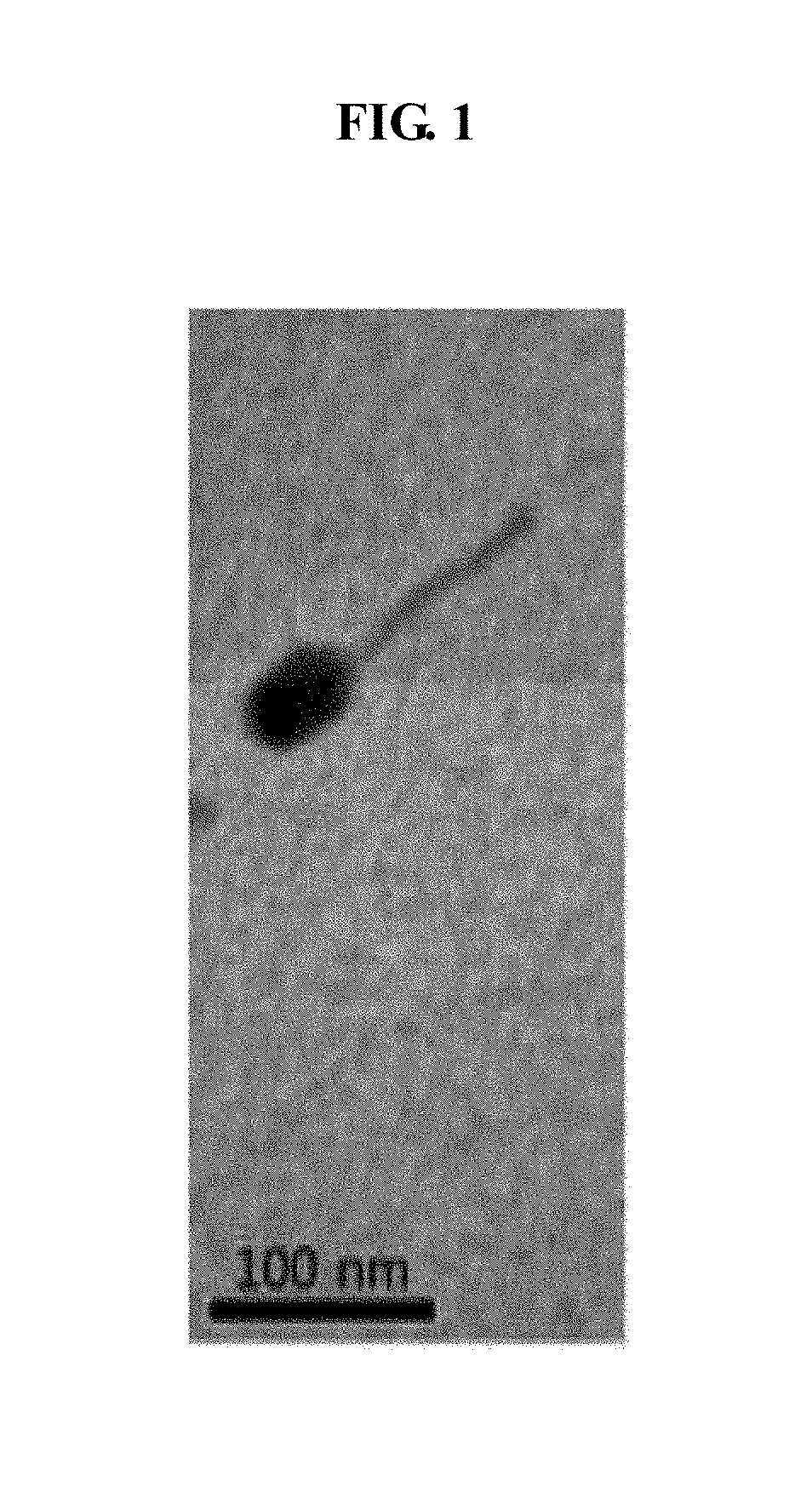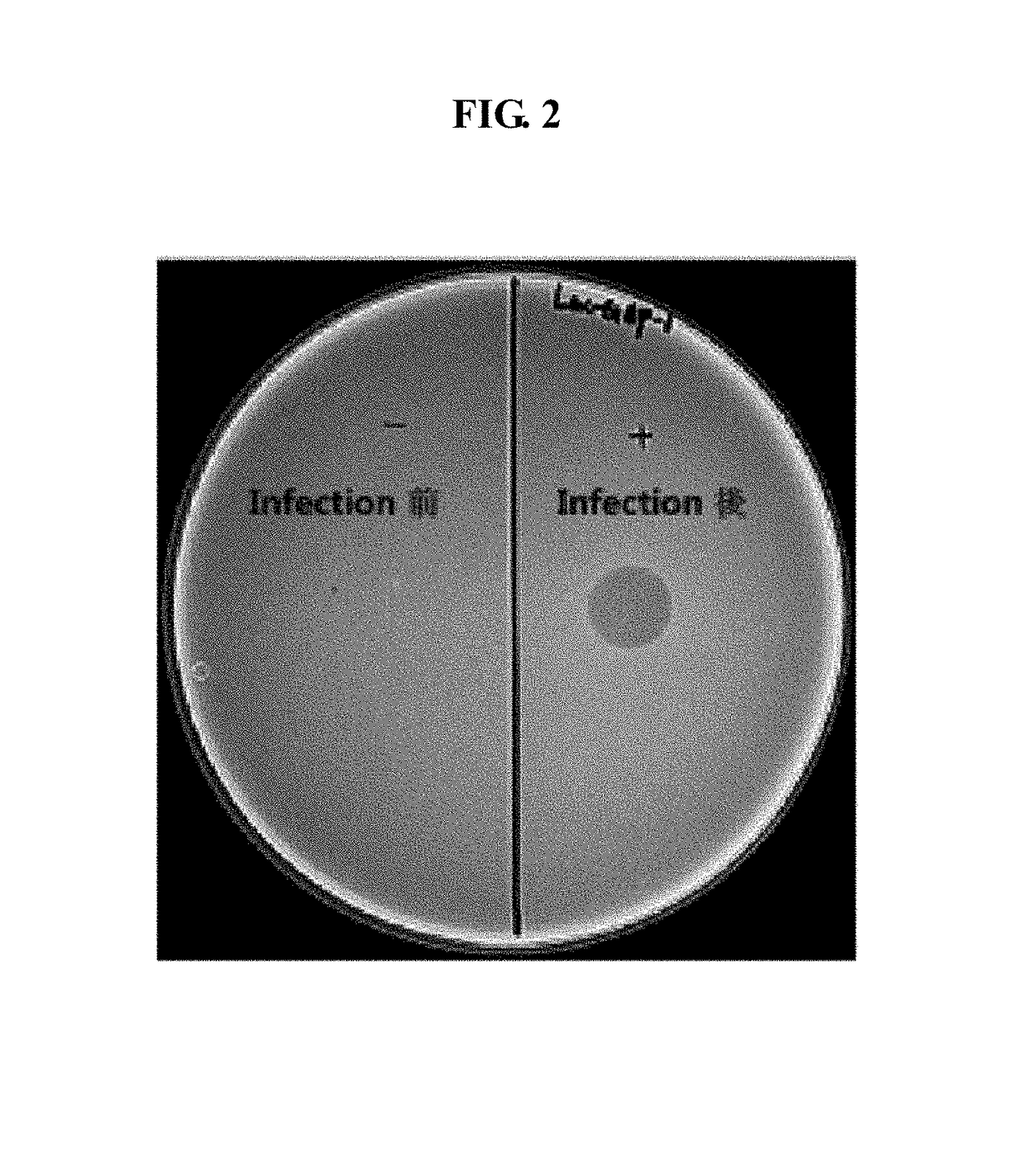Lactococcus garvieae bacteriophage Lac-GAP-1 and use thereof in suppressing proliferation of lactococcus garvieae bacteria
a technology of lactococcus garvieae and lactococcus garvieae, which is applied in the field of lactococcus garvieae bacteriophage lac-gap-1, can solve the problems of increasing the environmental pollution caused by feed around aquafarms, affecting human health, and affecting the economic value of the product, so as to achieve fewer side effects and high specificity
- Summary
- Abstract
- Description
- Claims
- Application Information
AI Technical Summary
Benefits of technology
Problems solved by technology
Method used
Image
Examples
example 2
n and Sequence Analysis of the Bacteriophage Lac-GAP-1 Genome
[0039]The genome of the bacteriophage Lac-GAP-1 was separated as follows. The genome was separated from the bacteriophage suspension obtained in Example 1. First, in order to eliminate DNA and RNA of Lactococcus garvieae included in the suspension, DNase I and RNase A were added 200 U each to 10 ml of the bacteriophage suspension, which was incubated at 37° C. for 30 minutes. 30 minutes later, to remove the DNase I and RNase A activity, 500 μl of 0.5 μM ethylenediaminetetraacetic acid (EDTA) was added thereto, which was incubated for 10 minutes. The suspension was further incubated at 65° C. for 10 minutes and then added with 100 μl of proteinase K (20 mg / ml) to break the outer wall of the bacteriophage, followed by incubation at 37° C. for 20 minutes. After that, 500 μl of 10% sodium dodecyl sulfate (SDS) solution was added thereto, followed by incubation at 65° C. for 1 hour. 10 ml of the mixture of phenol:chloroform:iso...
example 6
on of Feed Additives and Feeds
[0051]Feed additives were prepared by adding the bacteriophage Lac-GAP-1 solution at the concentration of 1×108 pfu / g feed additives. The preparation method thereof was as follows: Maltodextrin (40%, w / v) was added to the bacteriophage solution and then trehalose was added to reach 10 weight %. After mixing well, the resulting mixture was freeze-dried. Lastly, the dried mixture was grinded into fine powders. The drying procedure above can be replaced with drying under a reduced pressure, drying at warm temperature, or drying at room temperature. To prepare the control for comparison, feed additives that did not contain the bacteriophage but contained only buffer (10 mM Tris-HCl, 10 mM MgSO4, 0.1% Gelatin, pH 8.0) were prepared.
[0052]The above two kinds of feed additives were mixed with raw fish-based moist pellet at the volume of 250 times the volume of additives, resulting in two kinds of final feed additives.
example 7
on of an Immersion Agent (Medicine Bath Agent)
[0053]An immersion agent comprising 1×108 pfu / ml of bacteriophage Lac-GAP-1 was prepared. The preparation method was as follows: 1×108 pfu of the bacteriophage Lac-GAP-1 was added to 1 mL of buffer, which was well mixed. To prepare the control, the buffer itself that is the same with the one used for the mixture of the bacteriophage solution was prepared.
[0054]The prepared two kinds of immersion agents were diluted with water at the ratio of 1:1,000, resulting in the final immersion agents for the experiment.
PUM
| Property | Measurement | Unit |
|---|---|---|
| pH | aaaaa | aaaaa |
| body length | aaaaa | aaaaa |
| weight % | aaaaa | aaaaa |
Abstract
Description
Claims
Application Information
 Login to View More
Login to View More - R&D
- Intellectual Property
- Life Sciences
- Materials
- Tech Scout
- Unparalleled Data Quality
- Higher Quality Content
- 60% Fewer Hallucinations
Browse by: Latest US Patents, China's latest patents, Technical Efficacy Thesaurus, Application Domain, Technology Topic, Popular Technical Reports.
© 2025 PatSnap. All rights reserved.Legal|Privacy policy|Modern Slavery Act Transparency Statement|Sitemap|About US| Contact US: help@patsnap.com


